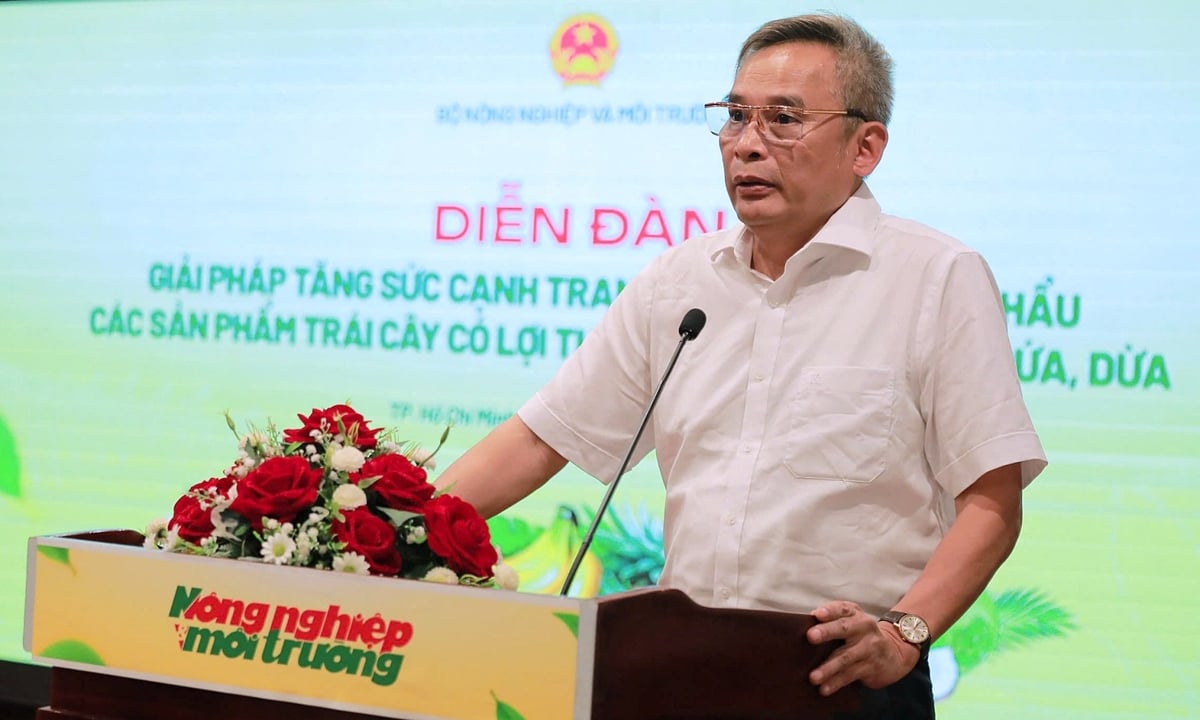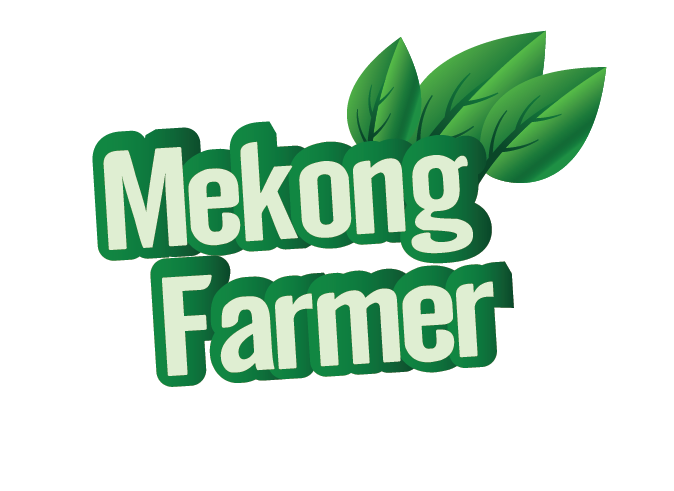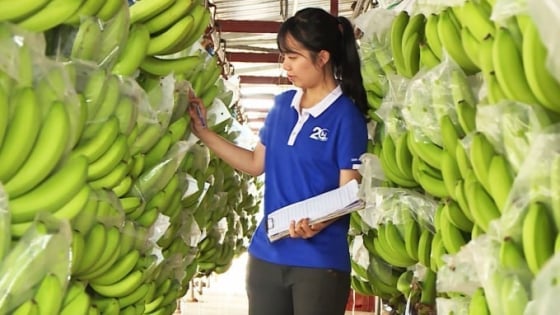(VAN) The value is not commensurate with the vast output. The banana industry is under pressure to standardize and transition to green, high-tech production in order to increase its competitiveness and expand its market.
Pressure to standardize and improve value
Bananas are a widespread crop in Vietnam, with cultivation extending from the northern midlands and highlands to the southern delta.
Bananas are presently the fruit with the highest output among key fruit crops and one of the agricultural products with a large export turnover for Vietnam’s agricultural sector. They are cultivated on over 161,000 hectares and produced nearly 3 million tons in 2024.

Mr. Nguyen Nhu Cuong: To date, durian has been the sole fruit product in the billion-dollar export division. Photo: Nguyen Thuy.
The Mekong Delta (39,000 ha), Southeast (25,000 ha), Northern Midlands and Mountains (26,100 ha), and Red River Delta (21,900 ha) are the main banana-growing regions at present, according to data from the Department of Crop Production and Plant Protection. The average banana yield in the country is 207.3 quintals/hectare, with the Southeast region obtaining the greatest yield at 344.8 quintals/hectare, the highest in the country. This results from a relatively high level of investment and technical application in the region.
Not restricted to domestic production, Vietnamese bananas have made a significant impact on the global market. Vietnam exported nearly 625,000 tons of bananas to China in 2024, which constituted the majority of China’s total banana imports. Furthermore, Vietnamese banana products are available in numerous high-demand markets, including the United States, Japan, South Korea, the EU, the Middle East, ASEAN (Malaysia, Singapore), and the EU.
The market potential for Vietnamese bananas is extensive; however, this necessitates more stringent standards. Mr. Nguyen Nhu Cuong, the Deputy Director of the Department of Science and Technology (Ministry of Agriculture and Environment), recommended that the banana industry continue to enhance product quality, strictly regulate cultivation processes, ensure food safety and traceability, and fully comply with each country’s phytosanitary requirements to maintain its current market share and expand into high-value markets.

Speakers at the seminar “Distinct Value Creates Competitive Advantage” (located within the Forum “Solutions to Increase Competitiveness, Promote Export of Advantageous Fruit Products: Passion Fruit, Banana, Pineapple, Coconut” organized by the Ministry of Agriculture and Environment on July 18) discussed the concept of “distinctive value.” Photo: Nguyen Thuy.
At present, the majority of bananas exported are in their unprocessed state, with a restricted amount of processed bananas. Value addition from profoundly processed products (such as dried bananas, banana juice, banana powder, and banana snacks) is essential for Vietnam to overcome price passivity, extend the value chain, and enhance competitiveness in the face of the increasing technical barriers imposed by importing markets.
The banana industry’s strategy until 2030 is to prioritize improving efficiency and value per unit of cultivation while maintaining an area of 165,000 to 175,000 hectares and a production of 2.6 to 3 million tons. This will involve refraining from excessive area expansion.
A novel direction for the banana industry
Numerous large-scale production models in Vietnam are demonstrating promising new directions, including the development of banana cultivation with advanced technology and the pursuit of a unified quality standard throughout the entire chain, from seedlings to traceability.
Unifarm Company’s approach establishes a unified standard designed to cater to the international market from the outset rather than being adaptable to each market or import standard.
The consistency in strategic design is the standout feature of this approach, according to Mr. Pham Quoc Liem, Chairman of Unifarm. Clear objectives, specific evaluation criteria, and modifications based on market signals are present in each production stage, from variety selection and cultivation area management to post-harvest handling. As a consequence, growers are not only involved in the production of bananas for sale, but they also contribute to a lengthier value chain in which quality and stability are critical components of the Vietnamese banana brand.
The estimated export value of bananas in 2024 is 378 million USD, which is equivalent to approximately 2,400 USD per hectare. However, this figure does not accurately reflect the industry’s true potential. According to industry professionals, Vietnam’s banana industry can accomplish a significant breakthrough by implementing high-tech solutions, developing new banana varieties that are resistant to Panama wilt, and organizing large-scale production in conjunction with modern logistics and processing.
The objective of achieving 20,000 USD/hectare is ambitious, but it is not unattainable if the entire chain adheres to the same quality standard.

Vietnam’s banana industry has the potential to become one of the nation’s primary agricultural exports. Photo: Illustration.
In a global context of heightened consumer health and environmental safety concerns, Vietnam will derive a long-term competitive advantage by producing bananas in a green, clean, and sustainable manner. Specifically, high-end markets such as the EU and Japan are increasingly requiring not only fruit quality but also social responsibility, traceability of growing regions, and environmental impact throughout the production process.
Bananas are evolving from a common crop to an industry with a sustainable export potential, a defined development strategy, and a large scale. In the years ahead, Vietnam’s banana industry must not merely remain a supplier; it must also establish itself as one of the most globally influential banana production centers in terms of output, quality, and production technology.
According to Assoc. Prof. Dr. Pham Anh Tuan, Director of the Institute of Agricultural Electromechanics and Post-Harvest Technology, the Institute is currently conducting research on preservation technologies that are appropriate for perishable fruits, including passion fruit, banana, and pineapple.
The Institute has developed a number of exceptional technologies, including the development of biodegradable coatings to extend the shelf life, heat pump drying, freeze-drying, ultra-fast freezing, and low-cost banana puree processing. The Institute is prepared to provide consultation and the transfer of appropriate technologies to businesses in order to improve the value chain and agricultural product preservation capacity, depending on the scale and actual requirements of businesses.
Agriculture News | Agri Products Price



